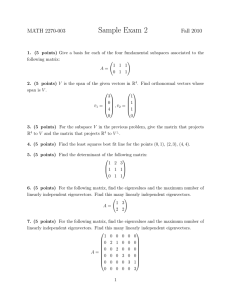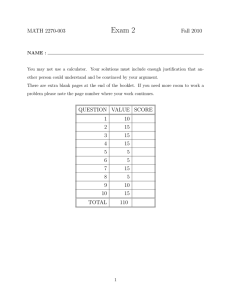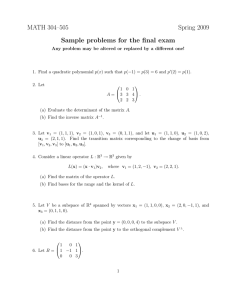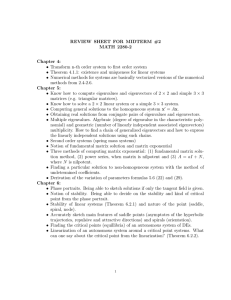Sample Exam 2 Solutions MATH 2270-003 Fall 2010
advertisement
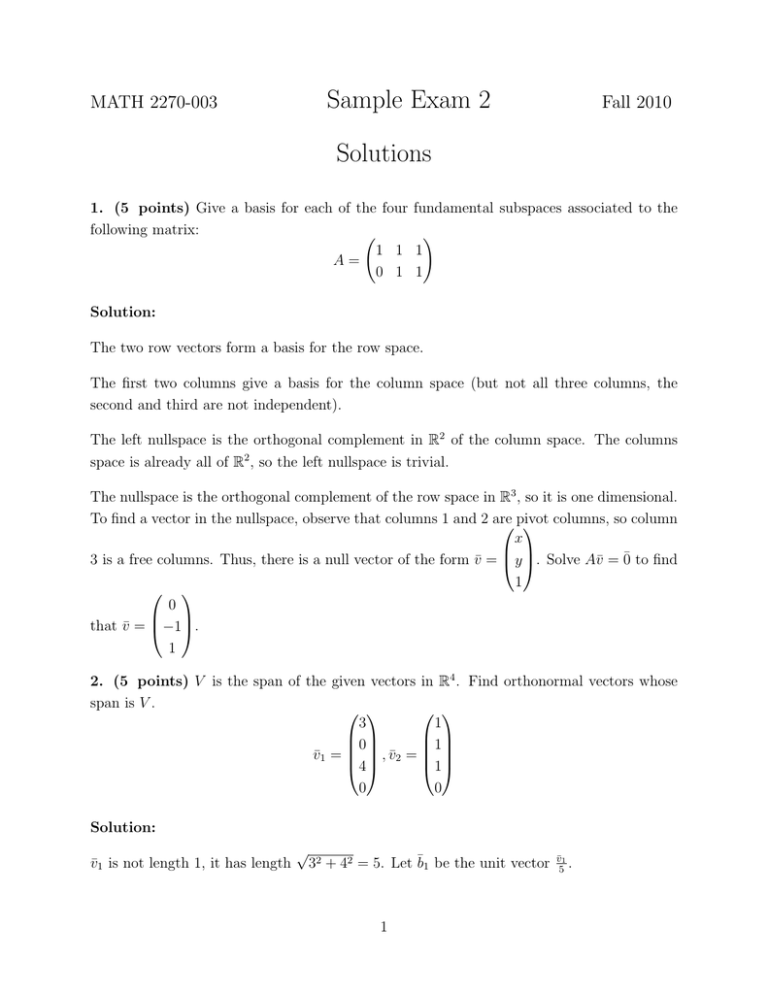
Sample Exam 2
MATH 2270-003
Fall 2010
Solutions
1. (5 points) Give a basis for each of the four
following matrix:
1 1
A=
0 1
fundamental subspaces associated to the
!
1
1
Solution:
The two row vectors form a basis for the row space.
The first two columns give a basis for the column space (but not all three columns, the
second and third are not independent).
The left nullspace is the orthogonal complement in R2 of the column space. The columns
space is already all of R2 , so the left nullspace is trivial.
The nullspace is the orthogonal complement of the row space in R3 , so it is one dimensional.
To find a vector in the nullspace, observe that columns 1 and 2 are
columns, so column
pivot
x
3 is a free columns. Thus, there is a null vector of the form v̄ = y . Solve Av̄ = 0̄ to find
1
0
that v̄ = −1.
1
2. (5 points) V is the span of the given vectors in R4 . Find orthonormal vectors whose
span is V .
3
1
0
1
v̄1 = , v̄2 =
4
1
0
0
Solution:
v̄1 is not length 1, it has length
√
32 + 42 = 5. Let b̄1 be the unit vector
1
v̄1
.
5
7
1
b̄1 · v̄2 = (3 + 4) = 6= 0,
5
5
so v̄2 is not orthogonal to b̄1 . Subtract off the “b̄1 –part” of v̄2 :
4
1
3
25
1
7 0
1
v̄2 − (v̄2 · b̄1 )b̄1 = −
= 3
1 25 4 − 25
0
0
0
This is orthogonal to b̄1 , but has length
r
r
4 2
3
1
1√
( ) + 12 + (− )2 = 1 +
=
26
25
25
25
5
4
25
1
Let b̄2 = 1 √126 3
5
− 25
0
{b̄1 , b̄2 } is an orthonormal basis of V .
3. (5 points) For the subspace V in the previous problem, give the matrix that projects
R4 to V and the matrix that projects R4 to V ⊥ .
Solution:
Let A be the matrix whose columns are the vectors b̄1 and b̄2 from the previous problem.
Projection to V is given by the matrix PV = A(AT A)−1 AT . Since A is orthogonal, (AT A) is
the identity matrix, so
√
3 26 4
!
3√26 0 4√26 0
0
25
1
√
PV = AAT =
25 · 26 4 26 −3
4
5 −3 0
0
0
10 · 25 20 12 · 25 0
10 45 12 0
125 −75 0
1
1
100
4 5 −3 0
=
=
25 · 26 12 · 25 −15 17 · 25 0 26 12 − 35 17 0
0
0
0
0
The projection to V ⊥ is given by ID − PV .
2
0
0
0
0
4. (5 points) Find the least squares best fit line for the points (0, 1), (2, 3), (4, 4).
Solution:
Let
0 1
A = 2 1
4 1
A line through
the three points would have slope m and y–intercept b that give a solution
!
m
v̄ =
to the equation
b
1
Av̄ = 3
4
1
However, 3 is not in the column space of A, so there is no actual solution. The best fit
4
line has slope and y–intercept given by
1
T
−1 T
v̄ = (A A) A 3
4
20 6
6 3
AT A =
so
(AT A)−1 =
1
24
1
(A A) A =
24
T
−1
T
!
!
3 −6
−6 20
!
−6 0 6
20 8 −4
1
1
T
−1 T
v̄ = (A A) A 3 =
24
4
The best fit line is
y=
18
28
x+
24
24
3
!
18
28
5. (5 points) Find the determinant of the following matrix:
1 2 3
1 1 1
0 1 1
Solution:
The determinant is 1. There are many ways to compute this.
6. (5 points) For the following matrix, find the eigenvalues and the maximum number of
linearly independent eigenvectors. Find this many linearly independent eigenvectors.
!
1 3
A=
2 2
Solution:
The characteristic polynomial is
1 − λ
3 = (1 − λ)(2 − λ) − 6 = λ2 − 3λ − 4 = (λ − 4)(λ + 1)
2
2 − λ
The eigenvalues are the roots of the characteristic polynomial: 4 and -1. Since there are two
distinct eigenvalues, there are at least two linearly independent eigenvectors, one for each
eigenvalue. Since the space is two dimensional there can be at most two linearly independent
eigenvectors.
!
−3 3
To find an eigenvector v̄1 for λ1 = 4 find the nullspace of A − 4ID =
. The
2 −2
!
−1
second column is −1 times the first, so v̄1 =
works.
1
To find an eigenvector v̄2 for λ2 = −1 find the nullspace of A − (−1)ID =
!
3
−
2
works.
second column is 23 times the first, so v̄2 =
1
!
2 3
. The
2 3
7. (5 points) For the following matrix, find the eigenvalues and the maximum number of
4
linearly independent eigenvectors. Find this many
1 0 0 0
0 2 1 0
0 0 2 0
A=
0 0 0 3
0 0 0 0
0 0 0 0
linearly independent eigenvectors.
0 0
0 0
0 0
0 0
3 1
0 3
Solution:
The matrix is in Jordan Form. The eigenvalues are the diagonal entries 1, 2, 3. There are
four Jordan blocks, so there are four linearly independent eigenvectors. For example:
0
0
0
1
0 1 0 0
0 0 0 0
, , ,
0 0 1 0
0 0 0 1
0
0
0
0
8. (5 points) Describe the plane in R3 that contains the three points (1, 0, 0), (1, 1, 1),
(1, 2, 0).
Solution:
0
The vector from (1, 0, 0) to (1, 1, 1) is v̄ = 1. The vector from (1, 0, 0) to (1, 2, 0) is
1
0
w̄ = 2. The plane containing the three points is collection (not a vector subspace) of
0
1
0
0
vectors 0 + a 1 + b 2, where a and b are arbitrary real numbers.
0
1
0
1
In other words, it is the vector subspace spanned by v̄ and w̄ shifted by the vector 0.
0
5
9. (5 points) Suppose an n × n matrix A has all eigenvalues equal to 0. Show that An
has all entries equal to 0.
Solution:
Solution 1: If all eigenvalues are 0 then the characteristic polynomial is λn . By the CayleyHamilton Theorem, A is a root of its characteristic polynomial, so An is the zero matrix.
Solution 2: A is similar to a matrix J in Jordan Form with 0’s on the diagonal and possibly
some 1’s on the first super-diagonal (immediately above the diagonal). Check that J k is a
matrix that is zero everywhere except possibly for some 1’s on the k-th super-diagonal, so
J n is the zero matrix. A = CJC −1 so An = CJ n C −1 is also the zero matrix.
10. (1000000 points) Prove the Cayley-Hamilton Theorem for matrices with real eigenvalues. You may assume the Jordan Form Theorem.
Solution:
No new questions beyond this point.
6


